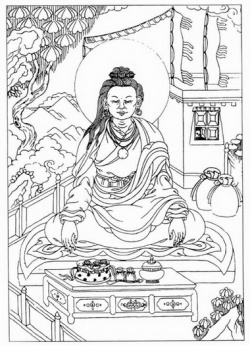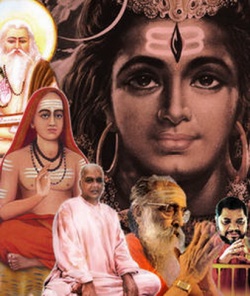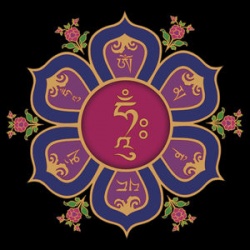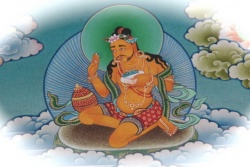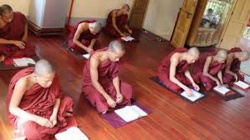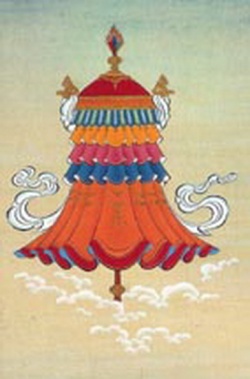The Buddhist-Confucian Conflict in the Early Chosŏn and Kihwa's Syncretic Response: The Hyŏn chŏng non
The Buddhist-Confucian Conflict in the Early Chosŏn and Kihwa's Syncretic Response: The Hyŏn chŏng non
Presented at the Annual Meeting of the American Academy of Religion, Chicago, Nov 20, 1994.
A. Charles Muller
Toyo Gakuen University
Introduction
Buddhism became established as a state religion in Korea during the sixth century, and was able to maintain that status with relatively little opposition throughout the Unified Silla and Koryŏ periods. However, at the end of the Koryŏ, the Buddhist establishment ended up in a serious confrontation with a rising Korean Neo-Confucian polemical movement, a confrontation in which it would end up being the clear loser. The nature of the developing Neo-Confucian polemic was twofold. The first aspect was an outcry against the economic privileges and excessive government influence of the Buddhist church. The second was a philosophical/religious opposition to Buddhist doctrine and practice, which had developed out of the writings of the Sung Neo-Confucian architects, most important of whom were the two Ch'eng brothers and Chu Hsi.
While there were anti-Buddhist memorials presented in Korea as early as 982, serious concentrated attacks on Buddhism did not begin until the mid-fourteenth century. The major initial charges, presented by individuals such as Yi Saek (1328-1396) were that excessive patronage was deleterious to the well-being of the state. The attacks made on Buddhism by Cho Inok (?-1396) and Chŏng Mongju (1337-1392) were also made on political and economic, rather than philosophical and religious bases. Toward the end of the fourteenth century the political and economic problems of the Koryŏ court intensified, and with the Buddhists firmly embedded in the body of a weakened political structure, Neo-Confucian activists came to the side of the rebel general Yi Sŏnggye. Sŏnggye eventually toppled the Koryŏ government, establishing the Chosŏn dynasty in 1392, and was by default endowed with a cabinet composed of Neo-Confucian advisors. After this time, the anti-Buddhist polemic took a sharp turn toward the philosophical in the writings of such prominent Neo-Confucian figures as Kong Hoebaek (1357-1402), Ho Ung (?-1411) and Chŏng Ch'ong (1358-1397), all of whom were active in the late 14th century. But the clear leader of the philosophically-based anti-Buddhist polemical movement was Chŏng Tojŏn (pen name: Sambong; 1342-1398).
Chŏng was a bright scholar who in his youth had the opportunity to study with the important Korean Neo-Confucian thinkers of his time. In 1383 he became an advisor to Yi Sŏnggye, and from that time until his assassination in 1398, held a major influence on Yi's policies. Chŏng's antipathy toward Buddhism was somewhat different from that of his predecessors in the one-pointedness with which he focused his polemic in terms of criticisms of Buddhism's philosophy and practice. Chŏng's anti-Buddhist philosophy was heavily influenced by the writings of the Ch'eng brothers and Chu Hsi, all three of whom had expressed in detailed treatises their opposition to Ch'an Buddhism's escapist, antinomian and nihilistic tendencies. Chŏng wrote a number of essays in which Buddhist ideas and practices were criticized, but his most systematic and comprehensive refutation of Buddhism was contained in his Pulssi chappyŏn (Arguments Against Mr. Buddha).
The first of the charges made by Chŏng in the Pulssi chappyŏn was that Buddhism encouraged people to abandon their family and society. Thus, Buddhist teaching was destructive to the five Confucian eternal relationships. Closely related to this argument was the charge that Buddhists regarded material existence as illusory and that only mind was real. Everyday affairs and human relationships were scorned and only quiet meditational inner cultivation was valued. This perception of Buddhism as a religion which regards the world as illusory and valueless and of Buddhists as people who absorb themselves in escapist meditation was the strongest unifying thread throughout the history of Neo-Confucian criticisms of Buddhism, and is the main theme of Tojŏn's argument in his treatise. He attacked the Buddhist lack of external cultivation through human relationships by citing Ch'eng-hao, who said, "the method of Buddhism includes the use of mindfulness to correct the internal, but does not include righteousness in order to correct the external.'" Along with this central religious reproach, Chŏng also included in his essay the whole gamut of criticisms that had been leveled against Buddhism since the beginning of its conflict with Confucianism in third century China. For instance, Chŏng revived the ancient argument of Buddhism being a "foreign" religion. He also accused Buddhism of being a harbinger of misfortune, supplying an arrangement of historical facts which imply that natural calamities necessarily follow the appearance of Buddhism. He also criticized the practice of begging for food, labeling Buddhists as parasites.
The Buddhist Response
Despite the frequency, intensity and ultimate effectiveness of the Neo-Confucian assault, both the number and power of the Buddhist responses were quite limited. John Goulde, the only Western scholar to my knowledge who has written at length on this topic, has attributed the weakness of the Buddhist response primarily to the high degree of canonicity attained by the Confucian teachings, which translated into a concomitant unassailability.[1] This was no doubt a contributing factor. But it seems that the doctrines of a Buddhist establishment, which had been in place for almost a millennium, whose leaders had been serving as intimate advisors to rulers for most of this period, in what was essentially a Buddhist country, should have held at least an equal amount of canonicity. Thus, in addition to Dr. Goulde's hypothesis, I would also like to offer a few other possible explanations for the relative lack of Buddhist apologetic.
One problem in constructing a serious defense for Buddhism lay in the simple fact that many of the Confucian charges held merit. That corruption was rampant in the Buddhist establishment is well-documented, and so it would not have been easy for Buddhist leaders to construct a convincing defense in regards to this issue. It would have been equally difficulty for mountain-dwelling Sŏn monks to compose a defense of charges of escapism and nihilism, which could also be written in the language appropriate to the same type of audience as had been the target of Chŏng's works. It is furthermore quite possible that the intellectual vigor and discipline of the nascent Korean Neo-Confucian movement was more than a match for a devitalized Buddhist sangha.
Despite the overwhelming force of the Neo-Confucian rise to power, there were a couple of Buddhist responses made during the decades following Chŏng's influential publications, one of which gained considerable notoriety. It is to this piece that we turn to next, and it his here that we introduce the main subject if this paper, Hamhŏ Tŭkt'ong, also commonly known by his posthumous name of Kihwa.
Kihwa
Kihwa was born in 1376, just sixteen years prior to the Koryŏ/Chosŏn dynastic turnover in 1392, into an family of the elite, and he was educated with other upper-class sons at the Confucian academy. While the Buddhist hagiographies must always be regarded with due critical distance, Kihwa's unusually ability in the Chinese classical texts is stressed to a markedly pronounced degree. Furthermore, a reading of his later works belies an unusual knowledge of, and reliance upon the Five Classics, Four Books and the Taoist canon. However, despite his deep Confucian training, at the age of 21 Kihwa decided to turn to the Buddhist path, after the tragic death of a close friend. After some years of wandering and study, he became a disciple of the legendary National Teacher Muhak (1327-1405), a master of the Imje Sŏn kong'an tradition. While under Muhak's tutelage, Kihwa underwent the first of his three major enlightenment experiences. He spent the rest of his days immersed in meditation, travel, teaching and an extensive literary pursuit that includes commentarial work, essay writing and poetry. Despite the diminished influence of Buddhism, toward the end of his life he served as a tutor to the royal family. After this stint, he retired once again to the mountain monasteries, where he taught and wrote until his passing away in 1433.
Although Kihwa is presently almost unknown to those outside the field of Korean Buddhism, it is likely that as the field becomes more fully researched, his name will be as commonly known as the major leaders of Chinese and Japanese Buddhism, as he is one of the most important figures in the history of Korean Sŏn. Along with the popular sixteenth-century Hyujŏng (1520-1604), he served as one of the two most important successors to Chinul's project of Sŏn-Kyo unification, writing insightfully on this topic throughout his works. His commentaries to two of Korean Buddhism's most oft-studied scriptures, the Diamond Sutra and the Sutra of Perfect Enlightenment, remain to the present the canonical Korean exegeses of these texts. His works have, beyond their Buddhist insights, been admired for their superior poetic quality, and for the degree to which they reflect both the philosophy and literary flavor of Korean Buddhism's most influential writer, Wŏnhyo.
Kihwa's works are marked by the pervasive application of the essence-function (ch'eyong) construction, which was derived originally from pre-Buddhist native East Asian thought, but adopted as a central hermeneutical tool in East Asian Buddhist philosophy. The essence-function hermeneutic, while prominent in Chinese and Japanese Buddhist works, received special attention in Korean Buddhism. The great influence of the essence-function construction in Korea can be traced to individuals such as Wŏnhyo, Ŭisang and Chinul, as well as to textual-sectarian influences such as the Awakening of Faith and Hua-yen traditions, which had special impact in Korea. For similar reasons, Kihwa's works are also distinctive in their use of the philosophy of interpenetration which was developed through the Hua-yen school, and whose principles were so deeply implanted into the Korean Buddhist consciousness by Ŭisang, Wŏnhyo and others.
But while showing these strong influences as a confluence of Hua-yen and Awakening of Faith thought, Kihwa's works are distinguished from his important Korean predecessors in the unusual degree of usage of Confucian and Taoist metaphor used to elucidate what might otherwise be regarded as purely Buddhist concepts. This deep mark of his classical back ground is evident in his poetry and essays, as well as in his commentaries on the Sutra of Perfect Enlightenment and the Diamond Sutra.
While Kihwa famous within Korean Buddhism for his impact on the texts used in Sŏn monastic education, the treatments accorded to him in general works on Korean religious history usually pay exclusive attention to his role as the single major Buddhist respondent to the Neo-Confucian polemic. One of the works to which Kihwa's authorship is attributed (Yusŏk chirŭi ron) is questionable for philological considerations which are not germane to this presentation, so we will focus on the work which is clearly his, and which is anyhow much more skillfully constructed, entitled the Hyŏn chŏng non (Expression of the Truth).
Earlier we noted the lack in both frequency and power of the Buddhist response to Neo-Confucian criticism during this critical period of time. Kihwa here stands out as a notable exception, but for explainable reasons in view of the circumstances outlined above. When listing the possible causes for the weakness of the Buddhist response to Neo-Confucian criticism, there was one possibility we did not discuss, which might be characterized as a deeper dimension of the hypothesis of unassailable canonicity. And that is, that there were a number of Buddhists, among whom Kihwa is exemplary, who were not as much in awe of an official canonical status of the Confucian classics as much as they held a genuine personal respect for the content of the Confucian (and Taoist) teachings. Kihwa did not see the three teachings of Buddhism, Confucianism and Taoism as antithetical or conflicting doctrines, but understood them to be varying expressions of a singular reality.
Using the ch'e-yong or "essence-function" formula, Kihwa explained that the single reality, or principle--that is, the enlightened mind of Buddhism, the Tao of Taoism and the jen of Confucianism, are in essence the same thing, differing only in terms of their linguistic expression according to the time and circumstance. The three teachings share on vital points: a belief in the basic goodness of the human mind (which we might call a sameness in essence) and the possibility for the proper actualization of that mind through training (or untraining). The ecumenical attitude that we are describing appears to be close to the p'an-chiao theories proposed by some of the earlier Chinese scholars, but there is a difference in Kihwa's approach which shows affinity with the syncretic work done by Wŏnhyo, in that Kihwa never categorizes the teachings according to any time period or set hierarchy. What he does argue for in terms of Buddhist superiority, is not a priority on a possession of the Tao, but a superiority within the tradition in terms of degree of actualization of the principle.
Kihwa's tone in the Hyŏn chŏng non is conciliatory throughout--he never responds with the emotional fervor and name-calling seen in the chappyŏn and other major Neo-Confucian works of the period. While Kihwa endeavors to answer all of the objections to some extent, the linchpin of his argument is the fact that he considers Confucians to have failed in grasping and actualizing the full implications of their own texts, most notably the primary Confucian principle of jen. The deepest implication of jen, argues Kihwa, has been expressed by Ch'enghao's line which says "the man of jen takes the universe and all the myriad things as his own body." Kihwa sees in this line as equivalent to the Hua-yen conception of the interpenetration of the universe by the enlightened Buddha mind. The problem, says Kihwa, is that Confucians have not adequately recognized these implications, which is obvious by their approval of the practices of ritual slaughter and hunting. He says, in the middle of the treatise:
How could the mutual inflicting of harm among people and the animals be the wish of Heaven and Earth? Humanity and the myriad things already possess the same material force (ch'i). While sharing in the same principle (li) of Heaven and Earth, they also share the same space in Heaven and Earth. Since they are already endowed with same material force and principle, where can there exist a separate principle which condones killing life in order to nourish life?! It is like these sayings: "The universe and I share the same root; the myriad things and myself are one body." These are the words of Śākyamuni. "The man of jen takes Heaven, Earth and the myriad things as his own body." These are the words of a Confucian. Only when one's words are fully in accord with his actions has he completed the Way of jen[2]
In the latter portion of the Hyŏn chŏng non Kihwa discusses the more superficial arguments which were also raised by Chŏng Tojŏn: that Buddhism should be discredited as a "foreign" religion; that Buddhism is a harbinger of personal and national calamity, and that the sangha is parasitic and corrupt. He dismisses the argument of "alienness" as somewhat ridiculous, asking how the Tao can be "Indian" or "Chinese." Where, he asks, is the "great center of the world"?[3] Against the argument that Buddhism has brought with it calamity, Kihwa first points out the great disasters that were endured even by the sage-emperors in pre-Buddhist times. He also reminds his readers that on the personal level, even Confucius and Yen-hui were unable to avoid poverty. He then points out the grand successes of the great Buddhist-influenced dynasties, the T'ang in China and the Unified Silla in Korea. To the charge of parasitism, Kihwa answers that Buddhists work hard at their own job, which is to bring goodness and succor to the masses. When people are lazy, he says, that is not the fault of Confucianism or Buddhism, it is an individual failure. He asks how critics can expect all Buddhist followers to be perfect. "Since the death of Confucius, have we seen another Yenhui?"[4]
It is not until the end of the essay that Kihwa gives answer to the charges of Buddhist nihilism. Here, he attempts to show through a somewhat stretched textual citation that Confucianism and Taoism also contain the doctrines of anātman and śūnyatā. Kihwa deals with the attack made on the Buddhist concept of no-self, not by attempting a philosophical proof of the doctrine of anātman, but again by questioning the attacker's understanding of his own Confucian tradition, citing examples in Confucian and Taoist texts which he considers to reflect the meaning of emptiness of self.
Kihwa's response can be characterized as being as practice-oriented as it is philosophical in that the core of his argument lies in laying hold of one of the Confucians' most central doctrines of "practice what you preach" and turning it back on them. In this sense, Kihwa is understanding the meaning of interpenetration, when applied in the real world, to imply a nonobstruction between saying and doing, or doctrine and practice.
It is obvious from an observation of following historical events that Kihwa's treatise had little lasting effect on the overall outcome of the Buddhist suppression. During subsequent decades, Confucian-sponsored government measures against the Buddhist sangha would grow more severe before they finally leveled off. The Hyŏn chŏng non nonetheless remains, much in the way of Tsung-mi's Origin of Man, a vitally important document for grasping the intellec tual climate at a time of great transition in Korean religious history. It is also a fine example of the writing of one of Korea's most important Buddhist philosophers.
Footnotes
Glossary of Sino-Korean Terms
ch'e-yong 體用
Chŏng Tojŏn 鄭 (1342-1398)
Chosŏn dynasty 朝鮮 (1392-1910)
Hamhŏ Tŭkt'ong; Kihwa; 涵虚得通 己和 (1376-1433)
Hyŏn Chŏng non 顯正論 (Exposition of the Correct)
Imje Sŏn 臨濟禪
Koryŏ dynasty 高麗풩 (918-1392)
Muhak Ch'acho 無學 (1327-1405)
Pulssi chappyŏn 佛氏雜編
Sŏsan 西山 (1520-1604)
Yi Sŏnggye j
Yuan-jen lun 原人論
Kihwa's works
(contained in the Han'guk pulgyo chonso 韓國佛經全書)
- Kumgang panyaparamilgyŏng o ka hae sorui 金剛般若波羅蜜經五家解説誼 (Annotated Redaction of Five Commentaries on the Diamond Sutra ). HPC 7.10-107.
- Kumgang panyaparamilgyŏng yun kwan 金剛般若波羅蜜經 (The Penetrating Thread of the Diamond Sutra) HPC 7.116-121.
- Taebangkwang won'gak sutara ryo ui kyŏng sŏrui 大方廣圓覺修多羅了義經説誼 (Commentary on the Sutra of Perfect Enlightenment). HPC 7.122-169.
- Sŏn Chŏng yonggajip kwaju sŏrui. 禪宗永嘉集 説誼 (Annotated Redaction of the Text and Commentaries to the Compilation of Yung-chia of the Ch'an school). HPC 7.170-216.
- Hyŏn Chŏng non. 顯正論 (Exposition of the Correct) HPC 7.217-225.
- Hamhŏ tang Tŭkt'ong hwasang orok 和尚語録 (The Record of the Teachings of the Reverend Hamhŏ Tŭkt'ong) HPC 7.226-250.
- Hamhŏ tang Tŭkt'ong hwasang haengchang (The Life of Reverend Hamhŏ Tŭkt'ong, by his student Yabu). HPC 7.250-252.
